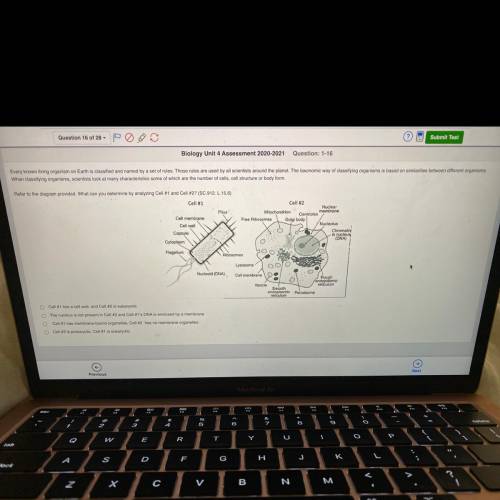
Biology, 09.03.2021 17:00 fredericksppeedddf
Every known living organism on Earth is classified and named by a set of rules. Those rules are used by all scientists around the planet. The taxonomic way of classifying organisms is based on similarities between different organisms
When classifying organisms, scientists look at many characteristics some of which are the number of cells, coll structure or body form
Refer to the diagram provided. What can you determine by analyzing Cell #1 and Cell 12? (SC.912. L.15.6)
Cell 1
Cell 2
Plus
Mtochondrion
Cel membrane
Free Ribosomes Golgi body
Cel wall
/Nucleolus
Chroma
Capsule
in nucius
(DNA)
Cytoplasm
Flagellum
Ribosomes
200
Nuclear
Centre membrane
os
NE
Nucleod (ONA)
Lysosome ca
Call merband
Rough
endoplasmic
Voice
reticulum
Smooth
endopamie Prosome
Cell 1 has a coll wall, and Cell 2 is eukaryotic
The nucleus is not present in Cell 2 and Coll 1' DNA is enclosed by a membrane
Cell 1 has membrane-bound organelles, Coll 2 has no membrane organelles
Cell 2 is prokaryotic Collis eukaryotic


Answers: 2


Other questions on the subject: Biology

Biology, 22.06.2019 00:00, mitetwojr
An organ system consists of a group of organs that performs specific functions necessary for the survival of an organism. humans have eleven different organ systems: integumentary, skeletal, muscular, nervous, endocrine, circulatory, lymphatic, respiratory, digestive, urinary, and reproductive. discuss the function of neurons, the brain and the spinal cord within the human nervous system while explaining the interrelationship of each organ.
Answers: 1

Biology, 22.06.2019 02:00, franksjamia
Which two factors contributed to creating a global culture? the creation of the united nations improvement in telecommunications health issues such as the ebola virus increased opportunities for global travel
Answers: 3

Biology, 22.06.2019 10:30, isabellemaine
Differentiate renewable and nonrenewable resources
Answers: 1

Biology, 22.06.2019 18:30, ellamai16
On a spring day, a middle-latitude city (about 40? north latitude) has a surface (sea-level) temperature of 10 ? c. if vertical soundings reveal a nearly constant environmental lapse rate of 6.5 ? c per kilometer and a temperature at the tropopause of –55 ? c, what is the height of the tropopause?
Answers: 3
You know the right answer?
Every known living organism on Earth is classified and named by a set of rules. Those rules are used...
Questions in other subjects:



English, 25.02.2020 18:50





English, 25.02.2020 18:50

History, 25.02.2020 18:50



